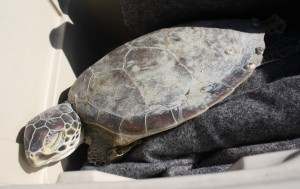
OCEAN CITY — A cold stunned green sea turtle that was transported from Ocean City to the Baltimore National Aquarium this week is recovering but still vulnerable.
“He isn’t completely out of the woods yet,” said Jennifer Dittmar, manager of the National Aquarium Animal Rescue team. “We consider him to be in critical condition. But he is showing improvement over the last 24 hours, which is a good sign.”
Dittmar clarified that while she is referring to the green sea turtle as “he” the gender of the turtle has not been identified, as it is a juvenile. The turtle is probably between 2 and 5 years old and weighed about five pounds when admitted into the aquarium.
The turtle has been confirmed as a green sea turtle, a species that’s uncommon to the waters around Ocean City.
“It is a green sea turtle. Green sea turtles are a little bit rarer for us to see in the area,” said Dittmar, “but we still do see them, just not as much as we see the loggerheads or the Kemp’s ridley.”
The green sea turtle was in poor health when it got to the aquarium. Sea turtles up and down the east coast have been turning up cold stunned over the last few weeks, with about 50 reported in Cape Cod. It is the “heart of cold stun season,” according to Dittmar, and the green sea turtle had a dangerously low body temperature earlier this week.
“His body temperature was about 38 degrees when he arrived [on Monday] and their normal body temperature should be anywhere between about 70 to 80 degrees,” said Dittmar.
But the turtle has been breathing on its own the entire time and has been gradually warmed up to about 60 degrees body temperature as of Tuesday. The process can’t be rushed because if the turtle is made too warm too quickly it could throw off the pH balance of its blood, causing it to become acidic and damaging to the turtle’s health.
There are also associated threats when a turtle is cold stunned.
“The cold stunning process can crash their immune systems and it opens them up to a lot of secondary infections,” Dittmar said.
The next few weeks will be critical for the turtle, as it will be continually monitored for any signs of infection. The aquarium will perform a radiograph, likely this week, to check for signs of secondary health issues. Trouble in the lungs is most common after a cold stun with systemic and blood problems also possible.
Once spring rolls around, if the green sea turtle is in good shape, Dittmar said that her team will begin to think about release either locally or further south, though it’s too early yet to know how that will play out.
For now, Dittmar is glad the turtle, which is one of 11 the aquarium is currently helping through a cold stun, is showing positive signs.
“He’s breathing on his own, he’s really alert and he’s actually in a pool right now doing a supervised swim test to see how active he is and how well he’s swimming on his own. And he so far has passed all of those tests,” Dittmar reported.
Coincidently, of the other 11 sea turtles recovering at the aquarium only the one from Ocean City is a green sea turtle. The other 10 are Kemp’s ridley turtles.
The turtle doesn’t have a name yet but will receive one in the next few days.
“Our naming theme right now is characters from Top Gun,” said Dittmar. “So he’ll eventually get a Top Gun character name.”
Unfortunately, one of the other cold stunned turtles is already named the appropriate “Iceman.”
